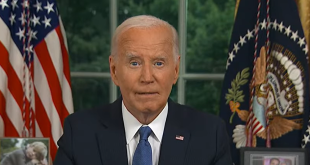As the Kremlin reveled in the failure of Congress to approve new military assistance for Ukraine and President Biden railed against Republican lawmakers for “kneecapping” an ally in their hour of need, Ukrainian soldiers, political leaders and Kyiv’s allies were all left asking the same question on Thursday: What happens if the United States stops providing military assistance?
Officials in President Volodymyr Zelensky’s government and Ukrainians across the country are still hopeful Congress will ultimately pass an assistance package — and have been cautious about saying anything that could ensnare them in America’s bitter domestic political battles.
But given the dire consequences if the United States cannot find a way to keep providing military assistance, officials in Kyiv are racing to bolster their nation’s own military capabilities and working to deepen ties with other allies who remain steadfast in their support.
However voting might go in other countries, “We will not stop defending our country — we will not give up a single piece of our land,” Oleksiy Danilov, the head of the Ukrainian National Security and Defense Council, said in a statement issued Thursday morning, hours after Republicans in the United States Senate blocked a measure to provide tens of billions of dollars more in aid to Ukraine.
“We will focus, draw conclusions, reload our weapons and continue to destroy the Russian monster,” he added.
The goal now, he said, was to make the nation’s military so strong that Ukrainians would not be “hostages to a changing political situation.”
Still, the uncertain prospects for more weaponry will reverberate on the battlefield, said Michael Kofman, a senior fellow in the Russia and Eurasia program at the Carnegie Endowment for International Peace. “U.S. military assistance to Ukraine is now running on fumes, and it is reflected by a tangible deficit of munitions at the front,” he said on Thursday.
A shortfall in funding could quickly compromise Ukraine’s air defense systems, Jake Sullivan, the White House national security adviser, said in an interview. Western and Ukrainian officials have credited those systems with saving countless civilian lives as the Kremlin has repeatedly targeted population centers over the past two years.
At the same time, Mr. Sullivan said, the supply of 155-millimeter artillery rounds — essential in the brutal fight along the front — would rapidly decrease.
“That will mean Ukraine’s ability to defend against advanced Russian attacks that are happening right now, and Ukraine’s capacity to take more territory, will be severely degraded,” he said.
Similarly, he added, the United States would no longer be able to send Ukraine air defense systems, like Patriot batteries and missiles that are estimated to cost $1 billion each.
“And so Ukraine’s capacity to intercept missiles and drones and rockets being fired to destroy civilian infrastructure, as well as to attack its military, will be severely degraded,” he said.
While funding debates play out in marbled halls of power, Ukrainian soldiers are battling across bloody trench lines to thwart relentless Russian assaults.
“It’s hell,” Andriy Babichev, a Ukrainian soldier with the 93rd Brigade, said in an appearance on national television. He is fighting to thwart relentless Russian assaults outside Bakhmut in Ukraine’s east. “It hasn’t been like this for a long time. Artillery cannonade from both sides is heard around the clock. The temperature is below zero. The mud is frozen.”
Ukrainian soldiers were killing Russians by the dozens, he said, but more kept coming. “I don’t know how many shells are needed to destroy them all.” Across the front, Ukrainian soldiers and commanders are having to make difficult decisions about how best to disperse resources that grow more limited by the week.
Already, the amount of weapons and other military aid has dropped sharply over the last several months as U.S. officials began to stretch out the money the Pentagon has left to spend.
Starting in late September, the value of arms that the Biden administration either sent Ukraine from its own military stockpiles, or bought from contractors on Kyiv’s behalf, dropped to the low hundreds of millions of dollars — down from a high of $2.8 billion in a single pledge in early January, according to Pentagon data.
The last two installments, which have been announced about every two weeks throughout the war, were particularly modest: $100 million in late November and $175 million on Wednesday.
Both of those aid packages were mostly made up of missiles and other ammunition, and included only one big-ticket item, a High-Mobility Artillery Rocket System, or HIMARS, of the kind that helped Ukraine seize territory from invading Russian forces around Kharkiv in the summer of 2022.
The Pentagon said recently that it had about $4.8 billion left to spend on military aid to Ukraine, and that this amount could last through the winter.
Oleksiy Goncharenko, a Ukrainian lawmaker with the opposition European Solidarity party, said if the U.S. Congress fails to find a way to send more assistance, “it will have a devastating effect,” on Ukraine’s war effort.
America provides about half the weaponry and ammunition directly to the Ukrainian army and about a quarter of foreign aid to the Ukrainian budget.
“Without U.S. military support, Ukraine will not give up but it will not be a question of successes, just holding on,” said Mr. Goncharenko, interviewed by phone on Thursday as he returned from a visit to Washington for meetings with members of both parties in Congress.
He said he had left the meetings worried that even Republican lawmakers who support Ukraine aid might balk at providing it to avoid challenges in primaries next spring from opponents critical of American spending on the war.
Ukraine’s Parliament passed a budget last month anticipating $41 billion in foreign aid, including $10 billion from the United States, he said.
Foreign aid is also directed at nonmilitary outlays, such as education and health care, but a reduction in these funds would require Ukraine to cut its own military expenditures to cover civilian needs.
It came as a positive signal for Ukraine that Mr. Biden suggested readiness for a compromise on border security, Mr. Goncharenko said.
“It’s up to U.S. citizens and their government to decide what to do with their border but unfortunately we became a hostage of it,” he said.
In recent weeks, other allies have stepped up with weapons donations, anticipating the need to fill any gap created if the United States steps back from its role as the single largest provider of military assistance to Ukraine since the start of the war.
Germany, in particular, announced last month that it would send four more state-of-the-art IRIS-T air defense systems to Ukraine in 2025, in addition to the three it has already delivered. Germany is also set to give Ukraine a third Patriot system this winter.
Some of the money that the United States spends to bolster Ukraine’s military is used to buy weapons from other countries — about $3 billion since the start of Russia’s full-scale invasion in February 2022, Pentagon figures show. The quiet diplomatic purchases have allowed the United States to obtain weapons from countries that have foreign relations with Russia and do not want to openly supply Ukraine.
In one recent example, the State Department reportedly bought 60 German-made antiaircraft gun tanks known as Gepards from the Jordanian government for about $118 million. American and Jordanian officials declined to comment on the reported sale.
Norway and Britain announced on Tuesday that they would launch a coalition to support Ukraine. Japan this week announced an additional $1 billion in assistance to Ukraine as well as their readiness to further increase the total to $4.5 billion.
Constant Méheut contributed reporting from Paris, Valerie Hopkins from Berlin and Nataliia Novosolova from Kyiv, Ukraine.
 Top Naija News – Nigeria News, Nigerian News & Top Stories Top Naija News – Nigerian Newspapers, Nigerian News. topnaijanews is a daily Nigerian newspaper covering Latest News, Breaking News, Entertainment, Sports, Lifestyle and Politics.
Top Naija News – Nigeria News, Nigerian News & Top Stories Top Naija News – Nigerian Newspapers, Nigerian News. topnaijanews is a daily Nigerian newspaper covering Latest News, Breaking News, Entertainment, Sports, Lifestyle and Politics.




